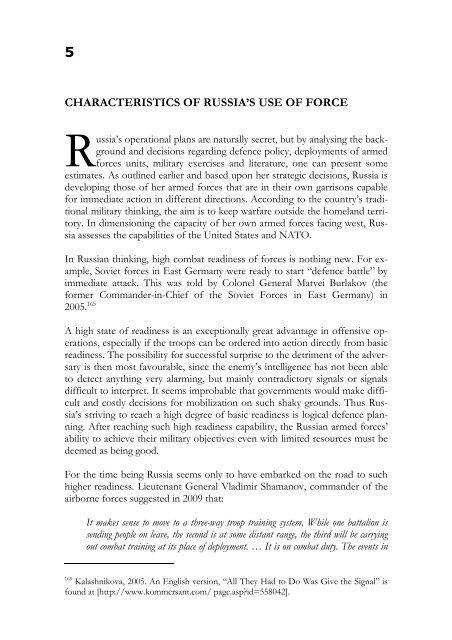the development of russian military policy and finland
the development of russian military policy and finland
the development of russian military policy and finland
You also want an ePaper? Increase the reach of your titles
YUMPU automatically turns print PDFs into web optimized ePapers that Google loves.
5<br />
CHARACTERISTICS OF RUSSIA’S USE OF FORCE<br />
R<br />
ussia’s operational plans are naturally secret, but by analysing <strong>the</strong> background<br />
<strong>and</strong> decisions regarding defence <strong>policy</strong>, deployments <strong>of</strong> armed<br />
forces units, <strong>military</strong> exercises <strong>and</strong> literature, one can present some<br />
estimates. As outlined earlier <strong>and</strong> based upon her strategic decisions, Russia is<br />
developing those <strong>of</strong> her armed forces that are in <strong>the</strong>ir own garrisons capable<br />
for immediate action in different directions. According to <strong>the</strong> country’s traditional<br />
<strong>military</strong> thinking, <strong>the</strong> aim is to keep warfare outside <strong>the</strong> homel<strong>and</strong> territory.<br />
In dimensioning <strong>the</strong> capacity <strong>of</strong> her own armed forces facing west, Russia<br />
assesses <strong>the</strong> capabilities <strong>of</strong> <strong>the</strong> United States <strong>and</strong> NATO.<br />
In Russian thinking, high combat readiness <strong>of</strong> forces is nothing new. For example,<br />
Soviet forces in East Germany were ready to start “defence battle” by<br />
immediate attack. This was told by Colonel General Matvei Burlakov (<strong>the</strong><br />
former Comm<strong>and</strong>er-in-Chief <strong>of</strong> <strong>the</strong> Soviet Forces in East Germany) in<br />
2005. 165<br />
A high state <strong>of</strong> readiness is an exceptionally great advantage in <strong>of</strong>fensive operations,<br />
especially if <strong>the</strong> troops can be ordered into action directly from basic<br />
readiness. The possibility for successful surprise to <strong>the</strong> detriment <strong>of</strong> <strong>the</strong> adversary<br />
is <strong>the</strong>n most favourable, since <strong>the</strong> enemy’s intelligence has not been able<br />
to detect anything very alarming, but mainly contradictory signals or signals<br />
difficult to interpret. It seems improbable that governments would make difficult<br />
<strong>and</strong> costly decisions for mobilization on such shaky grounds. Thus Russia’s<br />
striving to reach a high degree <strong>of</strong> basic readiness is logical defence planning.<br />
After reaching such high readiness capability, <strong>the</strong> Russian armed forces’<br />
ability to achieve <strong>the</strong>ir <strong>military</strong> objectives even with limited resources must be<br />
deemed as being good.<br />
For <strong>the</strong> time being Russia seems only to have embarked on <strong>the</strong> road to such<br />
higher readiness. Lieutenant General Vladimir Shamanov, comm<strong>and</strong>er <strong>of</strong> <strong>the</strong><br />
airborne forces suggested in 2009 that:<br />
It makes sense to move to a three-way troop training system. While one battalion is<br />
sending people on leave, <strong>the</strong> second is at some distant range, <strong>the</strong> third will be carrying<br />
out combat training at its place <strong>of</strong> deployment. … It is on combat duty. The events in<br />
165 Kalashnikova, 2005. An English version, “All They Had to Do Was Give <strong>the</strong> Signal” is<br />
found at [http://www.kommersant.com/ page.asp?id=558042].
















